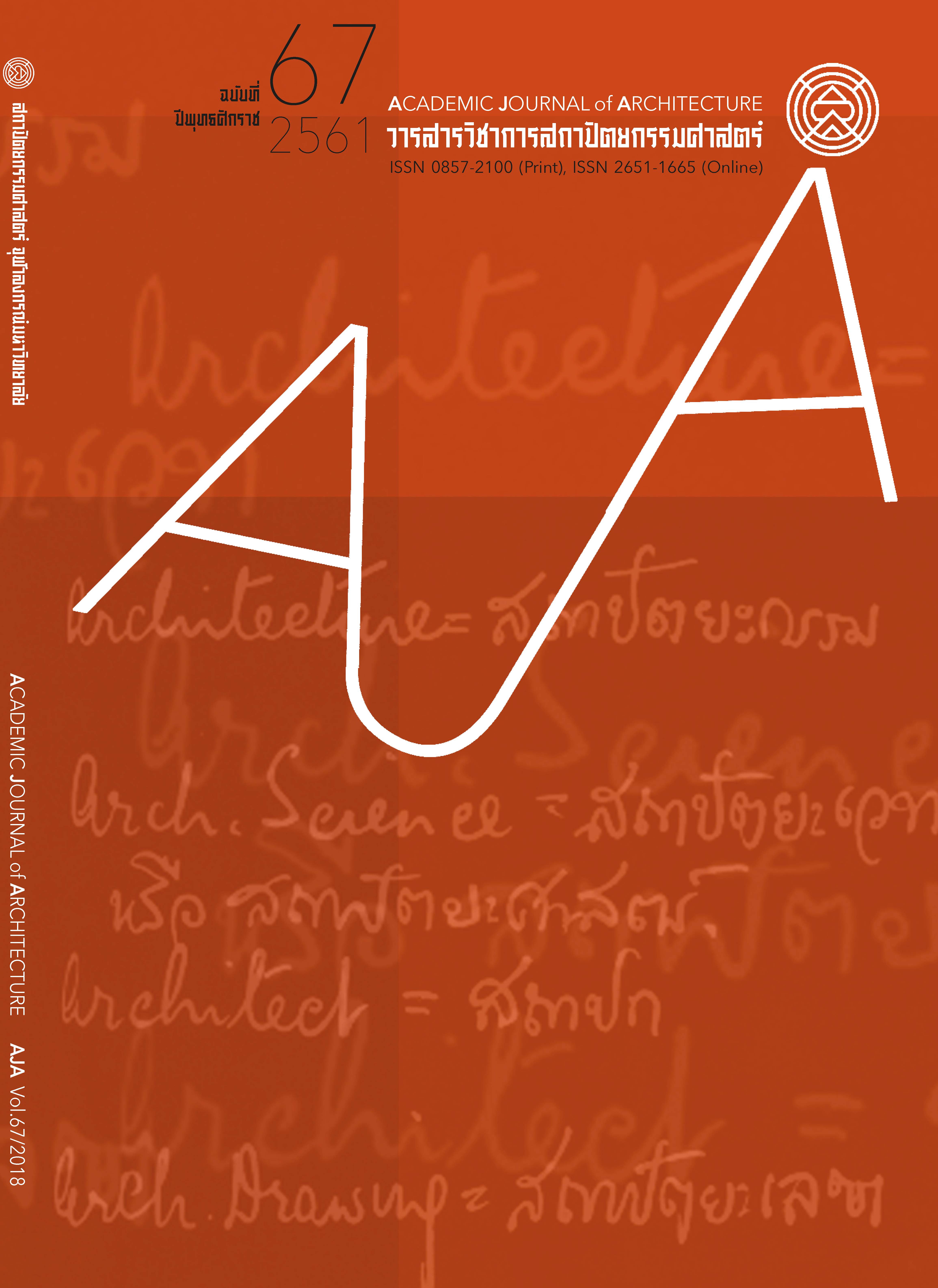Management Process of Preservation Districts for Groups of Traditional Buildings in Japan
Main Article Content
Abstract
The System of Preservation Districts for Groups of Traditional Buildings in Japan is a system which manages historical community conservation area. It is successful in terms of spreading historical community conservation to many local areas around Japan. The management system is divided into 4 processes: 1) observing community conditions for conservation; 2) determining preservation districts for groups of traditional buildings; 3) conducting historical community conservation; and 4) applying for the status of the important districts for preservation of a group of traditional buildings. The conservation is overseen by Japan’s Agency for Cultural Affairs, in collaboration with local administrative organizations, the public, and local scholars.
The successful management is attributed to the Agency for Cultural Affairs’ establishment of clear procedures and operational standards. The Agency for Cultural Affairs has also delegated conservation of historical community to local administrative organizations, enabling effective conservation of the community. Thanks to legal and financial mechanisms, the Agency has succeeded in inducing control, creating incentives, and ensuring sound knowledge impartation. Hence, the local organizations are able to correctly conserve historical community according to academic principles. In addition, promoting engagement with the public and establishing a central organization for conservation examination render historical community conservation tangible and in accordance with the community development directions. The findings from the study have been synthesized to give recommendations to related organizations regarding historical community conservation in Thailand.
Article Details
References
Agency for Cultural Affairs. “List of Important Preservation Districts for Groups of Traditional Buildings.” Accessed May 1, 2018. https://www.bunka.go.jp/seisaku/bunkazai/shokai/hozonchiku/judenken_ichiran.html.
Architectural Institute of Japan (AIJ). Community-Based Historical Townscape Conservation (Machinami Hozenkata Machizukuri). Tokyo: Maruzen, 2004.
Arnstein, S. R. “A Ladder of Citizen Participation.” Journal of the American Institute of Planners 35, 4 (July 1969): 216-224.
Ezura, T. “Creative Heritage Management and Utilization and Tourism in Preservation Districts of Groups of Historic Buildings.” Senri Ethnological Reports 61 (2006): 55–79.
Issarathumnoon, W. “Traditional Urban Community and Its Roles in Heritage Planning A Case of Bangkok Heritage Core.” PhD diss., The University of Tokyo, 2009.
Kawagoe City. “Announcement of Budget Supporting for Conservation Project in Kawagoe City Preservation Districts for Groups of Traditional Buildings (Kawagoeshi Dentoutekikenzoubutsugunhozonchiku Hozonjigyou Hojokinkoufu Youkou).” Kawagoe City, 2017.
Nishimura, Y. The Stories of Community-Based Townscape Conservation (Machinami Machizukuri Monogatari). Tokyo: Kokonshoin, 1997.
Nishimura, Y. Urban Conservation Plan (Toshi Hozen Keikaku). Tokyo: University of Tokyo Press, 2004.
Nishimura, Y., Masahiro, R., Tsuguo, S., Yoshihiro, I., Tachi, S., Shiro, S., Gobe, K., Tooru, T., Hideo, N., Kunpei, M. Hearing History of Community-Based Development (Shougen Machizukuri). Tokyo: Gakkugei Shuppan, 2011.
Okazaki, A. “A Study on Consensus Building System in Historical-Townscape-Conservation-Based Machizukuri Movement (Machinami Hozon Keishougata Machizukuri niokeru Gouikeisei Shisutemu nikansuru Kenkyu)” PhD diss., The University of Tokyo, 1999.
Onogawa to Sawara no Machinami wo Kanngaerukai (OSMK). 10 Years Step of Community Development – Historical Town Conservation and Renewal (Machizukuri 10 Nen no Ayumi – Rekishinomachi Hozon to Saisei). Chiba: Onogawa to Sawara no Machinami wo Kanngaeru kai, 2001.
Rahman, M. M. and Imon, S. S. “Conservation of Historic Waterfront to Improve the Quality of Life in Old Dhaka.” Archnet International Journal of Architectural Research 11, 2 (2017): 83-100.
Rodwell, D. Conservation and Sustainability in Historic Cities. Oxford : Wiley-Blackwell, 2007.
Shimotsuma, K. “Arrival Point of Community-Based Conservation and From Now On (Rekishi Wo Ikashita Machizukuri no Totatsuten to Korekara).” Oral Presentation at The University of Tokyo, Japan, 16 March 2018.
Siegenthaler, P.D. “Looking to the Past, Looking to the Future: The Localization of Japanese Historic Preservation, 1950–1975.” PhD diss., The University of Texas at Austin, 2004.
Sorensen, A. and Funck, C. Living Cities in Japan : Citizens’ Movements, Machizukuri and Local Environments. London: Routledge, 2007.
Tachakitkashorn, T. “Denken System in Japan: Important District for Preservation of a Group of Traditional Buildings.” Nakhara : Journal of Environmental Design and Planning 5 (2009): 55-68.
United Nations Educational, Scientific and Cultural Organization (UNESCO) and World Tourism Organisation (UNWTO). “Sustainable Tourism Management at World Heritage Sites.” Paper presented at Sustainable Tourism Management at World Heritage Sites International Conference Huangshan, March 24 - 27, 2008. Accessed May 3, 2018. https://sdt.unwto.org/sites/all/files/pdf/finrep_en_huangshan.pdf.
World Bank. Tourism for Development: 20 Reasons Sustainable Tourism Counts for Development. The World Bank Group, 2017. Accessed April 28, 2018. https://documents.worldbank.org/curated/en/ 55812150632462 4240/ pdf/119954-WP-PUBLIC-Sustainable TourismDevelopment.pdf.
ณัฐพงศ์ พันธ์น้อย. “ปัจจัยส่งเสริมกระบวนการมีส่วนร่วมของผู้มีส่วนได้เสียเพื่อพัฒนาการท่องเที่ยวในพื้นที่มรดกวัฒนธรรมมีชีวิต: กรณีศึกษาพื้นที่อิวามิกินซัง ประเทศญี่ปุ่น.” วารสารวิชาการ คณะสถาปัตยกรรมศาสตร์ จุฬาลงกรณ์มหาวิทยาลัย 63 (2557): 29–42.
ปรานอม ตันสุขานันท์. การอนุรักษ์ชุมชนเมือง. กรุงเทพฯ: สำนักพิมพ์แห่งจุฬาลงกรณ์มหาวิทยาลัย, 2559.
ยงธนิศร์ พิมลเสถียร. “ประเด็นวิกฤตเรื่องการอนุรักษ์ชุมชนประวัติศาสตร์ในเมืองสำหรับประเทศไทย.” หน้าจั่ว ว่าด้วยประวัติศาสตร์สถาปัตยกรรม และสถาปัตยกรรมไทย, 9 (2557): 100–119.
ศิริลักษณ์ เมฆอ่อนและมนสิชา เพชรานนท์. “ผลกระทบการท่องเที่ยวต่ออัตลักษณ์ชุมชน: กรณีศึกษาชุมชนแหล่งท่องเที่ยวอัมพวา.” วารสารสิ่งแวดล้อมสรรค์สร้างวินิจฉัย 12, 2 (2556): 1-19.


